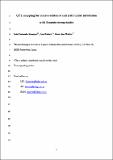Por favor, use este identificador para citar o enlazar a este item:
http://hdl.handle.net/10261/99209COMPARTIR / EXPORTAR:
 SHARE SHARE
 CORE
BASE CORE
BASE
|
|
| Visualizar otros formatos: MARC | Dublin Core | RDF | ORE | MODS | METS | DIDL | DATACITE | |

| Título: | QTL mapping for maize resistance and yield under infestation with Sesamia nonagrioides |
Autor: | Samayoa López, Luis Fernando CSIC; Butrón Gómez, Ana María CSIC ORCID; Malvar Pintos, Rosa Ana CSIC ORCID | Palabras clave: | Quantitative trait loci Maize Insect resistance Insect tolerance Yield under infestation Molecular markers Corn borer Sesamia nonagrioides Marker assisted selection Cross validation |
Fecha de publicación: | jun-2014 | Editor: | Springer Nature | Citación: | Molecular Breeding 34:1331–1344 (2014) | Resumen: | The Mediterranean corn borer (MCB) is the most important maize insect pest in the Mediterranean region. The main objective was to map quantitative trait loci (QTL) for yield performance under infestation with MCB, resistance and agronomic traits in a maize RIL population derived from an inbred cross European flint × Reid. Six QTL for resistance traits were located: one QTL for tunnel length (bin 9.03; p = 19.8 %), one QTL for stalk lodging (bin 3.07, p = 11.5 %), and four QTL for ear resistance (bins 1.07, 5.03/5.05, and 8.04; p = 25–63 %). Twelve QTL for agronomic traits were located: a QTL for yield under infestation (bin 5.03, p = 15 %); two QTL for grain moisture (bins 1.07 and 8.05); two QTL for days to anthesis (bin 1.07 and 8.05); two QTL for days to silking (bins 8.04 and 10.02); three QTL for plant height (bins 5.04, 8.05 and 9.03); and two QTL for ear height (bins 8.05 and 9.03). No genetic correlations between yield and other traits were observed. The cross validation (CV) approach showed that the estimation biases for QTL for resistance traits were higher than those for agronomic traits. This work stresses the importance of the region 9.03 for controlling corn borer resistance and suggests the presence of QTL with small effect on ear-resistance traits. At the same genomic region, there are also genes that control plant and ear height and future works could elucidate whether these genes are the same or are closely linked. The QTL for yield seem to play an important role in MCB tolerance in this genetic background. Large biases observed for QTL effects by CV were mainly due to the small sample size used and were higher for resistance traits due to their larger genetic complexity. We consider that it is more appropriate to select for grain yield under infestation instead of selecting for resistance traits because resistance to MCB could have unfavorable associations with agronomic traits. ©2014 Springer Science+Business Media Dordrecht | Versión del editor: | http://dx.doi.org/10.1007/s11032-014-0119-y | URI: | http://hdl.handle.net/10261/99209 | DOI: | 10.1007/s11032-014-0119-y | ISSN: | 1380-3743 | E-ISSN: | 1572-9788 |
| Aparece en las colecciones: | (MBG) Artículos |
Ficheros en este ítem:
| Fichero | Descripción | Tamaño | Formato | |
|---|---|---|---|---|
| Samayoa_QTL_mapping...pdf | 283,19 kB | Adobe PDF |  Visualizar/Abrir | |
| Files_QTL_mapping_for_maize_resistance.pdf | 327,46 kB | Adobe PDF |  Visualizar/Abrir |
CORE Recommender
SCOPUSTM
Citations
23
checked on 17-abr-2024
WEB OF SCIENCETM
Citations
19
checked on 27-feb-2024
Page view(s)
402
checked on 24-abr-2024
Download(s)
423
checked on 24-abr-2024
Google ScholarTM
Check
Altmetric
Altmetric
NOTA: Los ítems de Digital.CSIC están protegidos por copyright, con todos los derechos reservados, a menos que se indique lo contrario.
